Another Legislative Session Ends with Thousands Still in Solitary
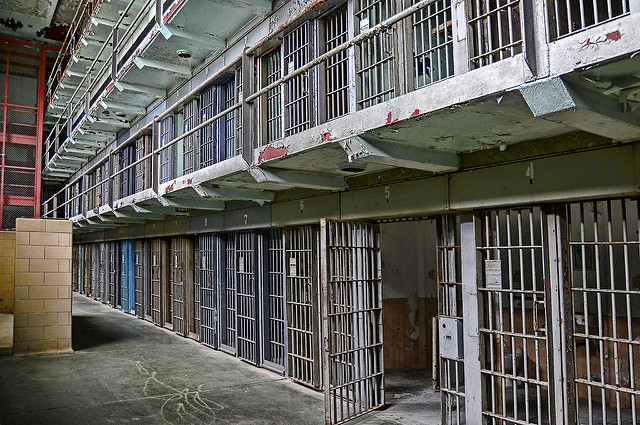
Earlier this month, I saw Mariposa & the Saint: From Solitary Confinement, A Play Through Letters. Actress and activist Julia Steele Allen plays Sara Foneseca, or Mariposa, as she is referred to in the play, and uses Mariposa’s own words to express her experiences in the Security Housing Unit (SHU) at a women’s prison in California. For the past ten years the two women have been corresponding through letters; the play is a collaboration that grew from this communication.
In one of the most disturbing parts of the play, Mariposa shares in a letter to Allen that a woman in the prison has committed suicide. Mariposa seems frantic and in shock at the calm response from the prison personnel. She exclaims there was no sense of urgency. It seems, she says, as if they were saying, “nothing to see here folks, just your average, run of the mill, scheduled suicide.” Mariposa tries to keep her spirits up although it is evident that she is slowly fading. At one point in the play she explains she refused to leave her cell -- even to shower -- for eight months.
The performance was followed by a workshop discussion on the issue of solitary confinement during which Regina, who was incarcerated in Albion Correctional Facility near Buffalo, New York, shared horror stories of her own experiences in “the box.” She noted that many of her peers were not even allowed to send or receive letters, practices considered privilege and meted out by the guards, despite being one of the only forms of human communication they had left.
There are 2.5 million people incarcerated today in the United States, and while it’s rare for the experiences of these people to be given a public viewing such as Mariposa provides, public demands to reform prison conditions and to end mass incarceration are growing. As are calls to end the torturous practice of solitary confinement.
Allen has brought “Mariposa & the Saint” on a national tour of eight states, including New York, which all have active campaigns and pending legislation to end or reform the conditions of solitary confinement. Humane Alternatives to Long Term (HALT) Solitary Confinement Act (A. 4401/S. 2659) is a piece of legislation that has yet to pass through the New York State Legislature, despite being introduced for years. This bill would create substantive alternatives to solitary confinement, place strict limitations on the use and permitted durations of confinement, and improve due process protections for people facing disciplinary infractions.
The Campaign for Alternatives to Isolated Confinement in New York (CAIC), a community group consisting of advocates, legal service providers, formerly incarcerated community members, and family members, has supported the HALT Solitary Confinement Act since 2014.
Last month, “Mariposa & the Saint” was performed for members of the state Legislature, hosted by the Women of Color Sub-Committee of the Black, Puerto Rican, Hispanic, & Asian Legislative caucus including Assemblymembers Maritza Davila and Latoya Joyner, along with Assemblymember Jeffrion L. Aubry, and state Senator Bill Perkins. Additionally, in early May, CAIC organized a lobby day which resulted in HALT now boasting more than 60 sponsors in the Assembly. Despite this support, the bill did not pass this year and remained in the Assembly’s Crime Victims, Crime and Correction committee until the end of the session. What was left out of the final Albany deals earlier this month was prison reform for thousands in solitary confinement, which has been denounced by Pope Francis, the United Nations Special Rapporteur, and President Obama.
The play was performed on Friday, June 10 at The New Settlement Community Campus in the Bronx, located in Assembly Speaker Carl Heastie’s home district in hopes of adding pressure to the Speaker so that he would use his authority to bring HALT to a vote before the session ended.
Solitary confinement is torture and can lead to devastating, lasting psychological consequences such as depression, alienation, suicide, and withdrawal. Solitary Watch estimates 80,000 to 100,000 incarcerated people are held in some form of isolated confinement at any time in the United States, most spending 23 or more hours a day in their cells. Dr. Terry Kupers told The New York Times, “many [formerly incarcerated individuals] still carried the psychological legacy of their confinement.”
New York State legislators did not act to reform the torture happening in their state prisons. Governor Cuomo, state legislators, and all New Yorkers must see and say that solitary is torture. It is time that we all demand reforms to end, or at least significantly limit, the use of solitary here in New York.
***
Jennie Encalada is a Brooklyn-based social worker and activist. On Twitter: @jenjeno07. Mariposa & the Saint completed it's 2015-2016 national tour this June, but has further plans. Learn more about the Campaign for Alternatives to Isolated Confinement (CAIC).
***
Have an op-ed idea or submission for Gotham Gazette? Email This email address is being protected from spambots. You need JavaScript enabled to view it.
Protecting the Soul of Flushing, and Beyond
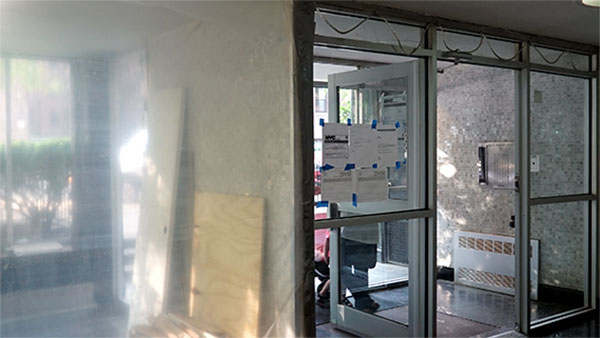
132-40 Sanford Ave in Flushing, a Treetop Development-owned rent-stabilized building
After more than a year of intensive community engagement, Flushing’s "under the radar" rezoning study of an 11-block waterfront area dubbed Flushing West was suddenly withdrawn by the Department of City Planning (DCP). The decision was prompted by a letter from City Council Member Peter Koo, who outlined a comprehensive list of outstanding concerns including “that the numbers don’t add up” for developers who perceive that the rezoning amounts to a “downzoning.”
DCP’s decision to pause the study elicited mixed reactions, in part because the rezoning study did spotlight the heavy infrastructural strain of Flushing’s white hot real estate market and unified multiple community stakeholders to protect the neighborhood’s rapidly diminishing affordable housing and advocate for equitable community development.
Mayor Bill de Blasio recently penned a Huffington Post column proposing that in the current market climate of hyper-gentrification, the city’s existential identity is defined by residents of public housing and rent-stabilized apartments. As the mayor opines, “It’s in protecting these people that we protect the soul of our neighborhoods.” I dare say the soul of Flushing has been under attack and protecting its diverse, working-class residents is long overdue.
Like many neighborhoods of color, affordable housing in Flushing is threatened by predatory equity investment. Investors target “underperforming” and “undervalued” multi-family residential buildings in strategic markets (i.e., “up and coming” and gentrifying areas). They count on capturing unrealized market value through replacing current tenants with those that can afford to pay higher rents or reselling properties at huge profits after making nominal capital improvements. Treetop Development LLC, one of the largest real estate companies in the New York City area, has a business model based on these “multi-faceted” strategies, to the detriment of communities.
Treetop’s online profile notes, “We actively acquire and transform existing rental properties in the region by modernizing living spaces, common areas and building systems before returning them to market. We are well-known for creating cutting-edge projects in neighborhoods coming up as desirable new addresses.” Since its establishment in 2005, Treetop Development LLC has been one of the region’s most active investors in multi-family properties including federally subsidized, project-based Section 8 developments and rent-regulated buildings.
In the past few years, Treetop has acquired and flipped numerous rent-stabilized buildings, generating huge profits. In July 2013, Treetop purchased 17-27 West 125th Street, a 50-unit rent-stabilized building in Harlem for $13.6 million. According to Treetop’s website, “17-27 West 125th Street boasts large apartments, which will be renovated upon vacancy to include new wide plank hardwood flooring, modern and chic kitchens and bathrooms, and stainless steel appliances.” After spending only $1.5 million on “signature” capital improvements, Treetop sold the building to Thor Equities for a whopping $30.6 million in August 2015 (a $17 million gross profit after 25 months of ownership).
Similarly in 2014, Treetop acquired a portfolio of six rent-stabilized buildings with a total of 139 rental and seven retail units in Washington Heights for $23 million. These properties, referred to as the "Columbia Audubon" portfolio due to their proximity to Columbia University Hospital and Audubon Avenue, were sold a little over a year later, in December 2015, for $36 million to a group of private investors.
In describing Treetop’s strategy to purchase and flip a multi-family portfolio in Central Harlem, co-principal Adam Mermelstein explained, “This portfolio is the perfect example of how picking the neighborhoods, identifying underutilized properties, effective management and recognizing the right time to buy and sell can pay tremendous dividends.” The portfolio purchased by Treetop for $22 million in 2013 was comprised of 12 five-story walk-up apartments and included rent-stabilized buildings on St. Nicholas Ave and Frederick Douglass Blvd. Two years later, Treetop sold the portfolio to a newly formed investment firm for $35 million, generating a profit equal to 59% of Treetop’s original purchase price.
Treetop Development LLC was featured in Crain’s New York Business for its enormous $138.8 million acquisition of eight rent-stabilized buildings in Queens representing the county’s largest multi-family transaction in 2015. Seven of the rent-stabilized buildings (totaling 489 apartments) are clustered in a three-block area near downtown Flushing and one building is in Elmhurst. Treetop wasted no time in making cosmetic upgrades to common areas such as lobbies and hallways, and renovating vacated apartments. A recent visit and conversation with a long-time, rent-stabilized tenant in one of Treetop’s Flushing buildings indicated that the common areas had already undergone capital improvements which permitted the prior landlord to increase rents.
Since Treetop’s acquisition, tenants have reported construction-related disruption and dust, spotty heat and hot water, and a sudden increase in vacant apartments. City Council Member Koo’s office has submitted a list of complaints pertaining to these buildings to 311.
This past year has been very busy for Treetop as it expands its extensive portfolio of rent-stabilized buildings in Harlem and Flushing, sold “select holdings at high profit margins,” and refinanced some properties through mortgage consolidation, as in the case of four Brooklyn properties including 188 South 3rd St., a rent-stabilized building in Southside Williamsburg. Among its early acquisitions in New York City’s multi-family market, Treetop paid a little over $5 million in August 2006 for the 41-unit building, intending to convert the apartments into upscale rentals. A few months later, various publications including the Metropolitan Council for Housing’s newsletter detailed the reasons why Treetop’s Mermelstein was named the city’s “most abusive landlord” by a group of tenant advocacy organizations.
Treetop’s 188 South 3rd St. was in the news again in July 2013 when a three-alarm fire erupted between the ceiling of the top floor and the roof. Over one hundred firefighters responded to the early morning blaze that took approximately two hours to extinguish. Several tenants were interviewed noting long-standing electrical problems and non-professional repairs. Charlin Ramos said to Brooklyn News 12, “I knew this was going to happen, I predicted it was going to happen.” Jacqueline Jimenez claimed Treetop ignored numerous calls from tenants. Extensive damage required many tenants to vacate and according to the Department of Buildings, the current status of 188 South 3rd St. is that a partial vacate order remains in effect as well as civil penalties and an outstanding Class 1 violation defined as “immediately hazardous.”
The same weekend that Mayor de Blasio’s column was published by Huffington Post, the New York Times published an opinion piece titled, How to Force Out Rent-Controlled Tenants. The timing and message of these articles underscore the precarity of rent-regulated housing that has been affordable to working-class New Yorkers. Key forces destabilizing the city’s neighborhoods, especially its communities of color, are the tactics deployed by predatory equity investors such as Treetop Development LLC. While the Flushing West rezoning study provided an opportunity to highlight the outstanding need for affordable housing, the current state of the neighborhood’s rent-stabilized housing requires immediate action to protect long-time tenants, or as the mayor would describe them, the soul of Flushing.
In early May, the Flushing West Community Alliance (FRCA) released a comprehensive research report that includes anti-harassment and anti-displacement measures. Based on numerous discussions with rent-stabilized tenants, FRCA recommends that landlords with a history of tenant harassment should not be able to receive permits necessary for renovations that will enable them to increase rents. At minimum, the four bills introduced to the New York City Council earlier this year, including Brad Lander’s “Certificate of No Harassment,” should be acted on immediately. Although the Flushing West rezoning process is temporarily on hold, speculative real estate market conditions have not abated which means rent stabilized tenants need strengthened protections now.
***
Tarry Hum is a professor at the City University of New York and author of Making a Global Immigrant Neighborhood: Brooklyn's Sunset Park.
***
Have an op-ed idea or submission for Gotham Gazette? Email This email address is being protected from spambots. You need JavaScript enabled to view it.
Demanding Justice is Not a 'War on Cops'
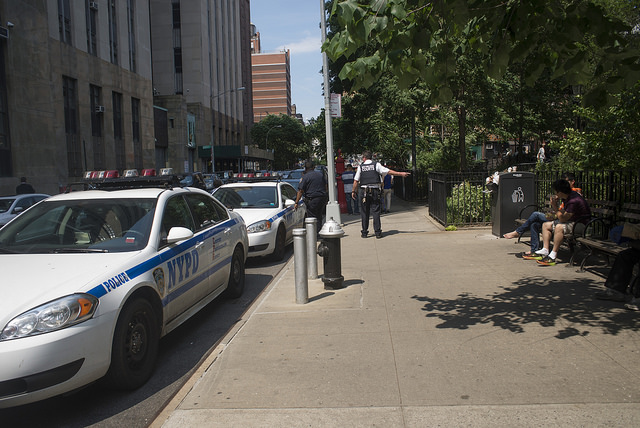
photo: Sofie Hecht, Gotham Gazette
The Manhattan Institute’s Heather Mac Donald has a new book out Tuesday that claims that there is a “War on Cops,” led by the Black Lives Matter movement and anyone else who ever called for reductions in excessive, heavy-handed, or brutal policing.
Mac Donald’s basic point is that the police merely take action in response to actual levels of crime and disorder and that by doing so they save lives. Anyone who accuses them of racist motivations or outcomes misses the fact that the majority of the lives they save are those of young men of color, she says, since they are so frequently the victims of criminal violence. According to Mac Donald, “there is no New York City institution more dedicated to the proposition that ‘black lives matter’ than the New York Police Department.”
She also maintains that when people criticize the police, they undermine the ability of officers to take the kinds of proactive actions needed to do this work, making all of us less safe. This is a rehashing of the so called “Ferguson Effect,” which Mac Donald has espoused and I and others have painstakingly debunked. For instance, crime in New York City has continued to go down, even when police went on a two-week strike last year and even after a now years-long radical reduction in “stop and frisk” encounters, which Mac Donald so vehemently defended in the past.
The “Ferguson Effect” is based on a logic that when police are told to stop killing people and behaving in an unlawful manner, they become incapable of doing their jobs. This is both an insult to police officers and leaves no room for people to raise very real and valid concerns about heavy-handed, racially-biased, and at times corrupt and brutal policing. As I asked once before, if I call to complain about broken swings in the playground, does that make me anti-parks? Or, if I complain that my trash didn’t get picked up, does that make me anti-sanitation? There are hundreds of thousands of police who understand and sympathize with many of the criticisms being raised, and to accuse them of shirking their responsibilities as a result suggests that Mac Donald holds a very dim view of the professional ethics of American police while she attempts to be one of their biggest champions.
In an excerpt of the book published in the New York Post, she accuses me of being out of touch with the desire of poor and non-white New Yorkers to live in neighborhoods free of crime and disorder. Nothing could be further from the truth. Even a cursory reading of my book City of Disorder: How the Quality of Life Campaign Transformed New York Politics, would reveal that I spent years doing fieldwork in just such neighborhoods. I found that people are indeed very concerned about disorder, and that politicians who ignore this do so at their own peril.
But I also went deeper than Mac Donald’s knee jerk neoconservatism. People in these neighborhoods only turned to police for help when all other avenues for assistance were closed off to them. From East New York, Brooklyn to the East Village in Manhattan, New Yorkers told me they wanted disorder dealt with through affordable housing, adequate mental health care services, drug treatment on demand, and after-school programs and stable employment for youth. It is only when austerity politics, supported by Mac Donald and the Manhattan Institute, made these things unattainable that people called for police-led responses.
Over the years I have attended many community meetings where people have demanded more aggressive police actions. I frequently bring my students with me to see the dilemmas facing communities, though many of them are well aware from first-hand experience. Most people in these meetings are deeply frustrated, and rightfully so. The decades of urban disinvestment and tax cutting mania have left them with declining living standards and in many cases a degraded quality of life—or displacement by the forces of gentrification. In my experience many of them are torn between having to rely on police to solve their community problems and knowing that this means putting more young people from the community in jail and prison. What people really want for their communities and their neighbors are resources and opportunities.
Mac Donald argues that there is nothing racist about the fact that the vast majority of people arrested and cited as part of “Broken Windows” policing are not white, because the police are only taking enforcement action where the crime is. She claims that Eric Garner, for instance, was targeted because it is only in communities of color that people sell illegal cigarettes. All I can say is that she’s never spent any time in the working class white neighborhoods of Brooklyn, where the illegal sale of untaxed cigarettes is rampant. She also clearly never hangs out in areas like Park Slope, Chelsea, and the Upper West Side where marijuana usage is widespread but enforcement near zero. Research conducted by Queens College’s Harry Levine shows that even when economic class is factored in, neighborhoods that have more non-whites experience dramatically higher enforcement rates than white ones.
If anything, it’s Mac Donald who is horribly out of touch. By supporting neverending budget cuts for every service but the police, she is oblivious to the dire consequences of grinding millions of young, poor, and disabled people through a criminal justice systems that mostly just makes their lives worse, and in cases like Kalief Browder and Eric Garner, results in their death. She should come and spend a day with my hard-working students at Brooklyn College and hear their stories of abuse, criminalization, and heartbreak that result from the NYPD’s war on disorder before she claims that the solution to every urban ill is more policing.
***
Alex S. Vitale is associate professor of sociology at Brooklyn College and author of City of Disorder: How the Quality of Life Campaign Transformed New York Politics. He is on Twitter @avitale.
***
Have an op-ed idea or submission for Gotham Gazette? Email This email address is being protected from spambots. You need JavaScript enabled to view it.
New York’s Next Climate and Community Protections
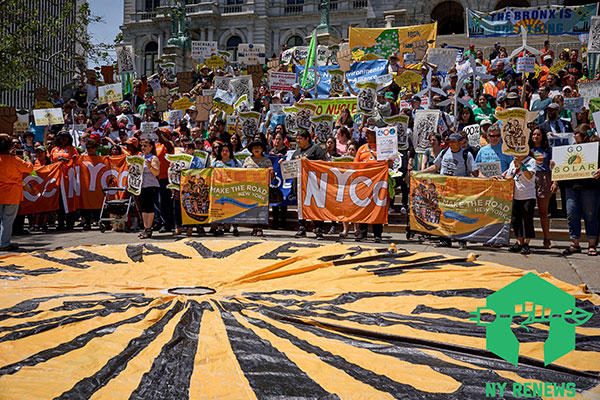
A major shift in the climate debate is taking place across New York and a new front in the discussion is emerging. No longer faraway images of drowning polar bears and epic glacial melt, climate change has moved into our own backyards, devastating our local neighborhoods. And no one knows this better than New York’s working families.
Extreme weather destroys upstate farmers’ crops and keeps hourly employees from getting to work. Air pollution exacerbates chronic health conditions, triggering asthma attacks and other health problems, such as heat exhaustion and heatstroke. And when a major storm hits, working families, particularly those from communities of color, are the last to see relief.
What once was solely an environmental debate for some has been transformed into an economic and social justice one. The frontlines of the crisis have made this so.
It was especially apparent here in New York during Hurricane Irene and Superstorm Sandy. Both storms caused massive flooding, knocked out power and water supplies, and displaced tens of thousands of families. Long-standing issues with toxic mold were revealed and compounded, and rodent infestations surged.
These problems were uncovered and exacerbated by storms like Irene and Sandy but they were not new. Policy choices and disinvestment in infrastructure over the last decade have caused working families across New York to live in an ongoing state of neglect, putting them at a disproportionate risk during major weather events.
But our future is not written in stone, and it’s time we bring justice and opportunity to the working people who are most impacted by climate change.
That’s why a coalition of more than 70 organizations including the most influential community leaders, grassroots activists, unions, and environmental justice advocates have banded together to stem the tide of climate change in New York. They are workers, immigrants, and people of color from both upstate and downstate New York. And they are throwing their support behind the strongest climate protection bill in the country – the NYS Climate & Community Protection Act (A.10342/S.8005).
This bill would make Governor Cuomo’s climate and clean energy commitments legally enforceable and set specific benchmarks and reporting requirements to ensure emissions reductions and rapid deployment of clean, renewable energy. And it would ensure the new clean energy economy creates good jobs by applying a prevailing wage to both construction and operations projects that include energy spending. In short, it would clean our air, improve our health, make our communities safer, and create new opportunities with a next-generation green economy.
The NYS Climate & Community Protection Act recently passed the state Assembly after a massive convergence of New Yorkers at the state Capitol demanded lawmakers support the bill. It is now being moved through the state Senate by Senator Diane Savino, who championed the 2014 Community Risk and Resiliency Act that was signed into law just after the People's Climate March, along with cosponsors Senators Tony Avella and Brad Hoylman.
We have an opportunity right now to set an example for the rest of the country to follow. The time is now for New York to rise to the occasion and make our state the gold standard for clean, renewable energy. That’s why we’re calling on Governor Cuomo and the rest of the state’s lawmakers to see this bill through, so New Yorkers get the climate change protections they need and New York gets the next-generation green economy it deserves.
***
Elizabeth Yeampierre is executive director of UPROSE. On Twitter @yeampierre.
Judy Sheridan-Gonzalez is president of the New York State Nurses Association. On Twitter @NYSNA.
***
Have an op-ed idea or submission for Gotham Gazette? Email This email address is being protected from spambots. You need JavaScript enabled to view it.
As Albany Fiddles on 421-A, New York City Suffers
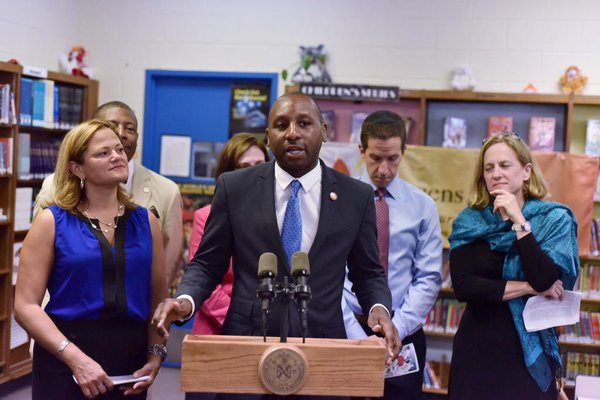
Council Member Donovan Richards, the author (photo: William Alatriste)
With officials in Albany about to pack up and head home, there is still some serious unfinished business.
Thanks to Albany’s failure to deliver a compromise between real estate and labor interests, it’s clear that we’ll see no movement on one of the most critical tools we have to build affordable housing: 421-A, the tax incentive program.
What a lot of us hoped was just a six-month pause in adding to the pipeline of new rental housing is at serious risk of becoming a long-term slump—and it could not come at a worse time for our city. New York City is growing fast, and grappling with the worst affordable housing crisis in generations. Half of all households are paying more rent than they can afford.
The old 421-A program that was up for renewal last year was hardly perfect - you’d be hard-pressed to find someone today who would say developers actually need a tax exemption to build and sell luxury condos.
But for all its flaws, the program did two very important things—the lack of which we’re feeling with every passing day.
One, it made it financially feasible to build rental housing, which is the housing New York actually needs right now.
And two, it was one of the only ways to secure affordable housing in some of the most expensive real estate markets in the city, places like Lower Manhattan, the Upper West Side, and Downtown Brooklyn. The reforms Mayor de Blasio pushed cut condos from the program, slashed subsidy per apartment, and strengthened affordable housing requirements citywide. But because of Albany’s inaction, we’ve never had the benefit of those improvements.
If this political impasse in Albany continues, we’ll see a city that’s less affordable, and more divided. The only kinds of buildings that will go up will be City-sponsored affordable housing and luxury condos—with none of the healthy rental housing in the middle that we need for the city’s growing workforce.
From Astoria to Upper Manhattan, construction sites are sitting vacant and projects are on hold. Building permits are down to levels we haven’t seen since the housing market crashed triggering the Great Recession. New rental housing has reached a standstill. And that means there is more and more pressure and demand on the housing we have today. If this keeps up much longer, rents are going to rise even faster than they already have—well outside the reach of working people.
Even though the City can continue building subsidy-driven affordable housing, we’ll lose the opportunity to build new affordable housing in exactly the parts of the city where it’s needed the most. 421-A was one of the few tools that could entice builders to construct affordable housing in hot markets, and the stringent affordability requirements the City Council and Mayor de Blasio secured would have only deepened that potential. What we’ll face if Albany doesn’t act is a more segregated, less diverse city. That’s not the New York we want.
New Yorkers should get angry. The City is doing everything in its power to protect neighborhoods and build a record amount of affordable housing. The proof is in the numbers: more than 43,000 affordable homes were financed in just two years – delivering enough affordable housing for more than 100,000 New Yorkers. The total is the largest number of new affordable apartments produced in nearly four decades. But, there is more that must be done, and we need Albany lawmakers to act.
This isn’t a crisis we can take on with one hand tied behind our backs. It’s time for the state Legislature and Governor Cuomo to work together to fix 421-A, passing the City’s reformed plan before more damage is done.
***
Council Member Donovan Richards represents District 31 in Queens, which encompasses Laurelton, Rosedale, Springfield Gardens and Far Rockaway. He is the chair of the Council’s Subcommittee on Zoning and Franchises. On Twitter @DRichards13.
***
Have an op-ed idea or submission for Gotham Gazette? Email This email address is being protected from spambots. You need JavaScript enabled to view it.
Hoosick Falls Residents, and All New Yorkers, Deserve Water Contamination Hearings
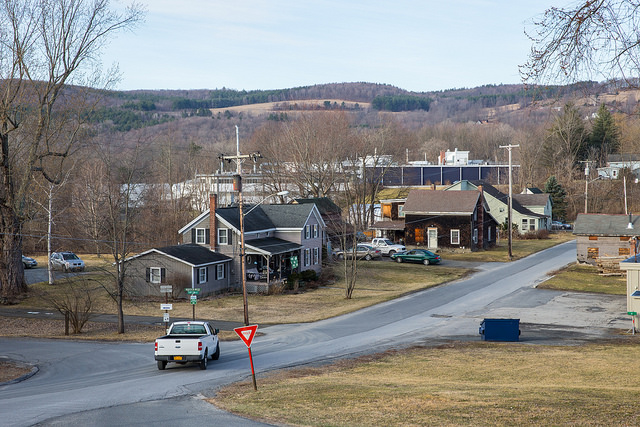
Hoosick Falls (photo via The Governor's Office on Flickr)
Just imagine knowing that the water you are drinking is quietly making you sick. That it gave you or someone you love kidney cancer. That it took years to get your government to listen, then when you got its attention, your concerns were downplayed.
The bond between clean water and our health has been broken as we’ve heard stories state- and nation-wide about contamination. And like Flint, Michigan, there is a great disconnect between the suffering of Hoosick Falls, New York residents and the actions (or in this case, inaction) of their own elected officials. Hoosick Falls residents are just 30 miles from the steps of the state Capitol in Albany, but that may as well be a million miles given the response from the people elected and hired to protect them.
State lawmakers should hold hearings on what has happened in Hoosick Falls and the flawed state reaction to the water crisis there. Governor Cuomo and his top officials should welcome hearings as a chance to show New Yorkers that they want to get to the bottom of the issue, protect constituents across the state, and that they will not make the same mistakes again. There are some who disagree, but they are wrong, and here’s why:
Hoosick Falls residents deserve to know what happened, and who knew what and when. Further, lawmakers cannot ignore that what has happened in Hoosick Falls is not limited to just that village. Grossly inadequate chemical regulations on the books in New York, coupled with an increased hunger by state Senators to “cut the red tape” (which translates into cutting resources and powers for enforcement of our laws) means that it is only a matter of time before another community is fighting another unregulated chemical which has fouled their water.
Hoosick Falls is like many New York communities, particularly upstate, with an extensive manufacturing history.
For decades, industries were allowed to operate virtually unchecked as their operations endangered residents. For many years, contaminations of this kind were seen as affecting other communities home to larger companies. General Electric, for instance, spent decades dumping PCBs into the Hudson River, up until the late 1970s. Meanwhile, outside Syracuse, Onondaga Lake became known as the most polluted lake in America after a century of pollution from predecessors of the very same company associated with Hoosick Falls contamination: Honeywell.
A lack of regulations and enforcement created a false sense of security for many communities – after all, if a chemical isn’t regulated, it’s not tested. And if it’s not tested, then how does anyone know if it’s in their water and affecting their health?
In May, when the federal Environmental Protection Agency (EPA) issued new safety levels for PFOA and PFOS, many localities suddenly found themselves with unsafe drinking water. Of course, the water had been unsafe for many years – but if no one knew to test for it no one knew there was a problem.
Since the crisis in Hoosick Falls became public, PFOA has been found in the drinking water of nearby Petersburgh, a community also now home to a Superfund site. PFOS has also been found in the City of Newburgh’s water; water in Suffolk County also exceeds safety levels.
Which brings us to the realities of today, and the unique role that state legislators have in holding hearings - public reckonings that help clarify what can and should be done to help people. Currently, there are more than 80,000 untested and unregulated chemicals on the market. The state Department of Environmental Conservation (DEC) has introduced emergency rules regulating PFOA and PFOS, but there are still tens of thousands of chemicals unaccounted for.
Resistance to legislative hearings is a head-scratcher. We’re pleased to hear that the Assembly has reopened the door to hearings; they should have occurred as originally planned following passage of the 2016-17 budget, which occurred April 1. This summer is now the time to follow through - no further delay is acceptable. These hearings should not be scuttled, the issues facing the people of Hoosick Falls and other municipalities must be seen in the light of day. It is legislators’ responsibility.
Hearings are a part of governmental checks and balances. Witness how rapidly the Senate rushed to hold a hearing on how to keep communities from imposing a fee to curb costly plastic bag waste. A public health crisis certainly deserves more proactivity than we have seen. Instead, the Senate is advancing a package of bills toward a vote that would exacerbate the very problems resulting from poor oversight and enforcement. In fact, one proposal forces agencies to enact a “one-in, one-out” practice when imposing new rules. In other words, when the DEC finalizes its PFOA rule, they would have to cut a regulation for the benefit of Honeywell International and Saint-Gobain, the companies responsible for the Hoosick Falls contamination.
The action that legislators take now will have enormous consequences for years to come. They must use their expertise in local affairs toward addressing their constituent concerns and public health hazards. The goal should be to consider contamination issues from across the state to connect the dots and create a game plan that modernizes our regulations and enforces our laws. New Yorkers must have confidence in both their drinking water and their elected officials.
Residents of Hoosick Falls and many other locales would be glad to hear that their elected officials are working throughout the summer to protect our water and our health. It’s an opportunity lawmakers should not pass up.
***
By Liz Moran, Water & Natural Resources Associate, Environmental Advocates of New York. On Twitter @greenwatchdogNY.
***
Have an op-ed idea or submission for Gotham Gazette? Email This email address is being protected from spambots. You need JavaScript enabled to view it.
Advanced Placement Expansion Means Opportunity for All
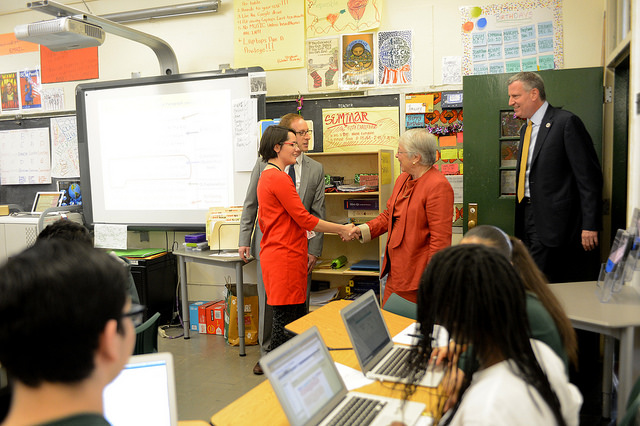
photo: Rob Bennett, Mayor's Office
Education is a democratizing force. As we work to build a more equitable and even stronger public school system and city, it is our responsibility to ensure all our students – regardless of where they attend high school – are prepared to enter and graduate college.
As a lifelong Hunter student, I have been the beneficiary of tremendous good fortune through access to high quality education, and I feel compelled to pay it forward. I am grateful that my parents knew the benefits of a Hunter education early on, but this awareness is far from universal. I founded Promoting Access to Specialized Schools in New York City (PASSNYC) chiefly to tackle the lack of awareness of the admissions process and opportunities afforded by the city’s specialized high schools. At PASSNYC, we believe that educational access and achievement are paramount in creating a more just and progressive society.
These schools offer some of the most transformative opportunities for students from all socioeconomic backgrounds. Yet, PASSNYC’s work recognizes that there will never be enough seats for all of the talented students that would benefit from attending.
Advanced Placement courses are powerful tools that serve talented students and help them make the most of their college experience. AP courses engage our high school students and allow them to explore subjects in depth, but most importantly, research shows that they prepare students for the rigors of a college education. An AP class on a student’s transcript makes their college application more competitive. AP exam credits often count toward degrees, allowing students to graduate faster and with less debt.
Unfortunately, outside of the specialized high schools, many students lack access to AP classes and support for AP exams. Citywide, there are still over 100 schools that lack AP courses, and many more that don’t offer a full slate of APs, especially in the all-important STEM subjects. These schools disproportionately serve low-income and black and Latino students.
The de Blasio administration’s new “AP for All” initiative aims to change that by giving all New York City students access to at least five AP classes by the fall of 2021. Monday’s announcement of the first AP for All expansion is welcome news: 63 high schools will offer new AP courses next school year, including 35 that don’t currently offer any AP courses at all.
At Hunter College High School, I was surrounded by some of the most ambitious students the city has to offer. In this environment, it was not unheard of for a single student to earn a top score on seven AP exams before graduating. I have seen firsthand how the challenge of AP courses brings out a level of drive and motivation that can power students through the course and on to college. Many of my former classmates are most thankful for their high school AP teachers, citing them as essential to their current success. In hindsight, it is remarkable how much I was offered and took for granted.
We can’t afford our bright young minds missing out on opportunities that put them on the road to enrolling and succeeding in college – or that can spark the passion to become an engineer or a doctor – just because of their neighborhood.
AP for All will give more students in need the means to demonstrate their potential and talents, starting with thousands getting new opportunities across 63 high schools next year.
PASSNYC is aligned with the City’s approach to focus support on both teachers and students.
As AP for All expands to reach every high school across all five boroughs, more New York City students than ever will be equipped with the resources, knowledge, and confidence to succeed as college students and face the challenges that lie ahead.
***
Ryan Baxter, founder and chairman of PASSNYC, a not-for-profit, volunteer organization dedicated to broadening educational opportunities for New York City's talented underserved students. On Twitter @PASSNYCorg.
***
Have an op-ed idea or submission for Gotham Gazette? Email This email address is being protected from spambots. You need JavaScript enabled to view it.
Time for Restorative Justice in Our Schools
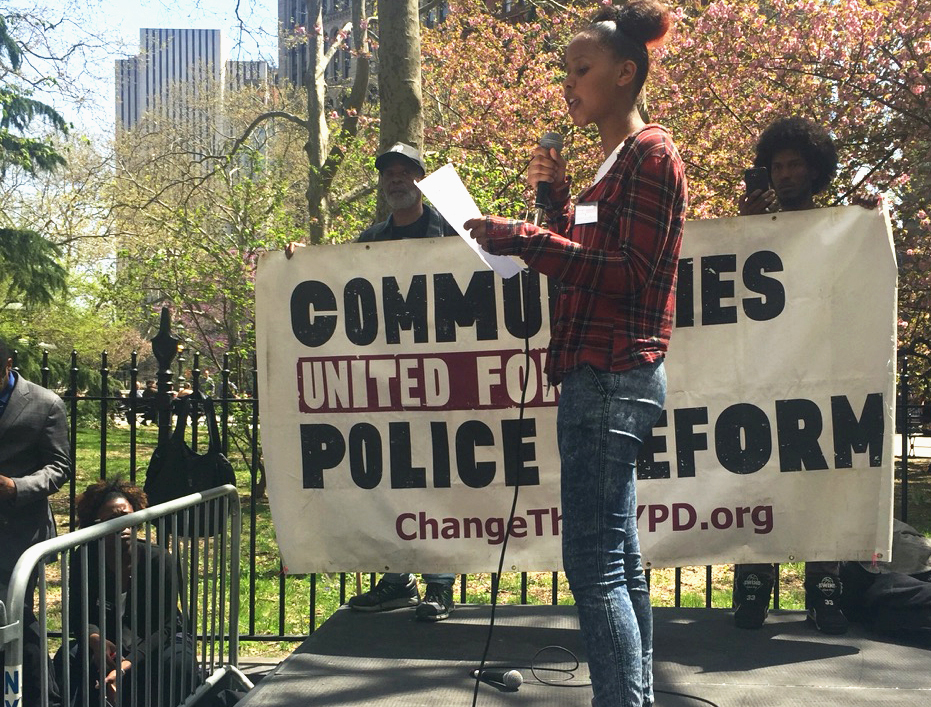
Zaire Kiran Agostini, the author
Being a black girl in New York schools is hard—the stereotypes and biases we face are painful, and often overlooked. Too often, they lead to suspensions and arrests of young people like me that take us out of school and push us toward the streets, prison, or worse. Now is the time for New York State to take action to address the damage being done by out-of-touch school discipline policies.
When teachers or administrators look at girls like me talking with my friends, they look at us like we are always about to cause trouble. If we speak up for ourselves, they say we’re being defiant. Even when we are having fun together, like joking around and dancing, they view our behavior as inappropriate. And then, too often, they discipline us.
Youth of color are treated differently than white youth across our state, and data proves that is a reality. Black girls in sixth to eighth grade in New York City, for instance, are eight times more likely than white girls to be suspended two or more times. Being black is the biggest indicator that you will be suspended or arrested in school. Latino students are also more likely to face harsh discipline.
The majority of suspensions and criminal summonses are not for violent and dangerous reasons. They are for minor infractions like “defying authority” or “disorderly conduct”—infractions that the Department of Education’s Office of Civil Rights acknowledged can be biased and unfairly impact students of color.
In school every day, the first thing that greets us is police officers and a metal detector. It’s demoralizing and, for many of us, can be traumatizing. Once inside the building, students like me face stereotypes that we will never graduate, that we will drop out and have a child, that we are trouble waiting to happen. It feels like the system isn’t built to build us up and support us, but to break us down mentally and emotionally. Research shows the presence of police leads only to an increase in students being arrested for minor incidents. Instead of investing in students, our state is investing in the school-to-prison pipeline. And it’s time for that to change.
Assemblymember Catherine Nolan has introduced a school discipline bill that would make a real difference for students like me. Her proposal, which just passed the State Assembly’s Education Committee, will help to sustain healthy and inclusive learning environments by encouraging schools to approach discipline using restorative practices and ensure fair and equitable discipline for all students, especially students of color and students with disabilities. This restorative justice approach—which engages constructively with young people and limits ineffective measures like suspensions and expulsions—has been tried successfully in schools across New York City and is now being expanded with support from the City Council.
The State must embrace restorative justice and positive discipline strategies, too. The first step: with momentum coming out of the Education Committee, the New York State Assembly should pass the Nolan bill, and send a strong message to the state Senate and Governor Cuomo that we must embrace a bright future for young people like me.
***
Zaire Kiran Agostini is a youth leader with Make The Road New York and the Urban Youth Collaborative. Follow their work on Twitter: @MaketheRoadNY @UYC_YouthPower.
***
Have an op-ed idea or submission for Gotham Gazette? Email This email address is being protected from spambots. You need JavaScript enabled to view it.
Time to Say and Do More for Women's Health
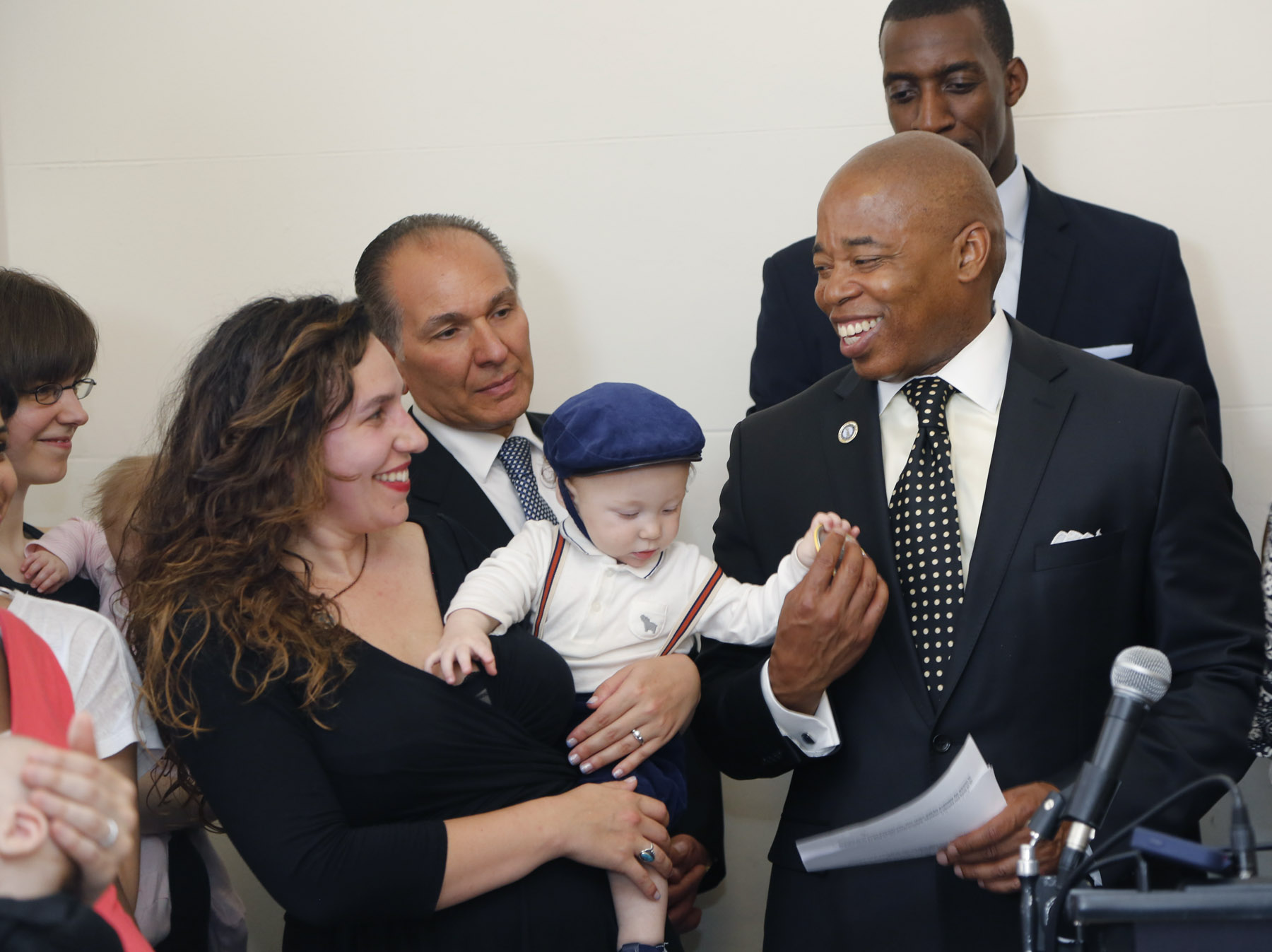
Brooklyn Borough President Eric Adams
Tampons. Periods. Breastfeeding. Hot flashes.
These terms, and others relevant to women’s health, have traditionally been considered taboo — inappropriate for polite conversation and therefore left unmentioned. That silence has had serious consequences for women and girls, who are denied access to feminine hygiene products, charged more at the cash register for “women’s” versions of household items, and made to feel ashamed about their bodies.
This taboo extends to sexual health, with terrible costs for young adults who have been denied information about reproduction, contraception, and healthy relationships. As a result, the United States has disproportionately high rates of unintended pregnancy, sexually transmitted infections, and domestic violence.
The lack of healthy dialogue on these matters has delivered unhealthy results. Thankfully, strong leaders are stepping up and speaking out, and we’re beginning to see the benefits. Through the leadership of elected officials such as State Senator Sue Serino and Assembly Member Linda Rosenthal, with support from Council Speaker Melissa Mark-Viverito and Council Member Julissa Ferreras-Copeland, the New York State Legislature recently voted to eliminate the sales tax on tampons, sanitary napkins, and other feminine hygiene products. (Governor Andrew Cuomo has pledged to sign the bill).
Just as we provide an exemption from the sales tax for necessities such as groceries and clothing, feminine hygiene products will be properly defined as necessities for women who menstruate, not luxuries. The exemption will particularly assist low-income New Yorkers who have had to choose between or ration such basic necessities due to their limited resources.
New York City now has an opportunity to build on the momentum from this achievement. The City Council is preparing to hold a hearing on a critical proposal by Council Member Ferreras-Copeland and Speaker Mark-Viverito to offer feminine hygiene products for free in public schools, homeless shelters, and correctional facilities.
This is a logical extension of our shared interest in promoting common-sense public health measures, both physical and psychological. Consider that a girl in school who has her period but is not carrying tampons or pads must visit a guidance counselor or the school nurse and explain her situation, often needing to negotiate hall passes and having to wait to be seen - the entire experience seems to have been intended to maximize embarrassment and class time missed. In jail, each woman receives a very limited supply of feminine hygiene products each month while additional supplies are sold for extortionate prices at the commissary; many must improvise with rolled-up toilet paper, a humiliating and unhealthy situation. Any woman or girl who is forced to use menstrual items for long stretches of time, due to issues of access or affordability, is put at higher risk for cervical cancer, toxic shock syndrome, and other concerns resulting from product overuse.
We need action at all levels of government. In homeless shelters, many women and girls simply cannot afford to buy feminine hygiene products, as Supplemental Nutrition Assistance Program (SNAP), Women, Infants, and Children (WIC), and flexible spending accounts disallow such purchases. Legislation such as the Fund Essential Menstruation (FEM) Products Act of 2015 from Representative Grace Meng, which would reclassify feminine hygiene products to allow for purchase with flexible spending accounts, is essential to move forward and should be a bipartisan priority. For starters, we should ensure that every member of the New York State congressional delegation gets behind the bill.
These initiatives are critical to eliminating inequities that undermine the position of women in our civil society. A recent report from the New York City Department of Consumer Affairs (DCA), for example, documented that products sold to women cost seven percent more on average than nearly identical products sold to men. This includes basic hygiene products such as shaving razors. We have a shared responsibility, men and women alike, to demand that these disparities end now. Companies that continue this behavior need to be called out in the public arena and pressured to answer for these discrepancies.
We must continue to drive the conversation about gender equity, especially around women’s health, to break the silence and remove the taboos. When I became Brooklyn borough president, I was deeply concerned that women who have recently had children are often ostracized for breastfeeding and pumping milk at work or in public areas, despite the fact that the law protects their right to this practice. I was proud to open our lactation lounge at Brooklyn Borough Hall last year, as part of the Breastfeeding Empowerment Zone initiative by the New York City Department of Health and Mental Hygiene (DOHMH), so women in Downtown Brooklyn have a comfortable lounge in which to breastfeed or pump milk. And, we are able to raise awareness of the benefits of breastfeeding and to celebrate the practice.
I am now pressing forward with City Council Members Laurie Cumbo, Robert Cornegy, Jr., and Corey Johnson (the latter are two of the standout male leaders in the fight for advancing women’s health) on a proposal to require the City to create dedicated space for nursing moms in a range of municipal government offices that serve the public, such as New York City Human Resources Administration (HRA) job centers and New York City Administration for Children’s Services (ACS) borough offices.
This conversation should include the entirety of women’s lives. Our society has often avoided discussion of menopause, depriving many women of information about the symptoms of menopause such as hot flashes and an awareness of available treatments. In our celebration of Women’s History Month this past March, Council Member Cumbo and I organized a day of panel discussions and workshops to speak with women about every stage of life and to start a conversation surrounding the natural changes that occur in life, not only physically, but also emotionally and spiritually. For some, it was the first time anyone had engaged them on these topics. We ask businesses and other institutions to follow suit and to reasonably accommodate these life transitions.
The days of relegating women’s health to second-class status or worse are over, and our laws and policies must reflect that for every stage of a woman’s life. Men, who still write most of those laws and policies, have a responsibility to join in this conversation and to insist on fairness and equality.
***
Eric Adams is the president of Brooklyn. On Twitter @BPEricAdams.
***
Have an op-ed idea or submission for Gotham Gazette? Email This email address is being protected from spambots. You need JavaScript enabled to view it.
Paying the Overhead for Democracy in New York
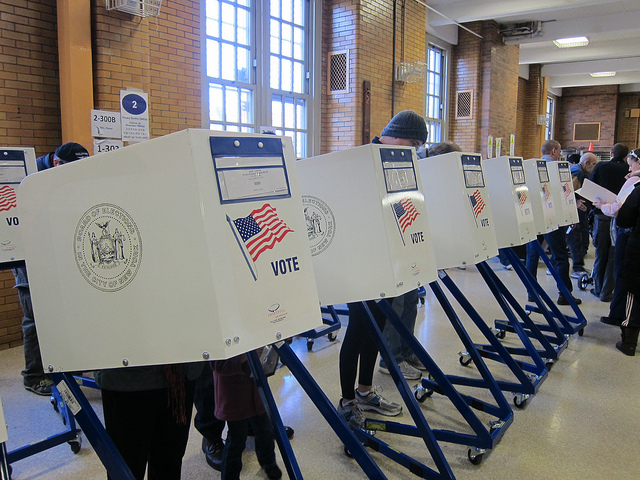
(photo by Peter Duton)
My dad Ruby Benjamin worked as a professional basketball player, a New York City cop, a hosiery salesman and, for much of the second half of his life, the owner of a liquor store on West 31 Street, between Broadway and Sixth Avenue. He loved his first two jobs, but liked the last one the best (the sales job was another story entirely.) Twelve hours a day, six days a week in the store was grueling. “But nobody tells me what to do, Jerry,” he’d say to me. “I’m my own boss.”
Being the boss brought responsibilities that never came up when you worked for the city or some big company. “It costs money to put the key in the door,” my father said. “You have to cover the overhead.” The heating bill was yours. So was the lighting bill. If you needed pens and pencils and scotch tape you could not bring them home from the office. You had to buy them.
But it was worth it, because no one told you what to do.
We like to say that our representative democracy is a system in which the people rule; we are the owners of our governments, or ought to be. Ruby has been dead for almost a decade. But lately, as I’ve read daily about one campaign finance scandal after another, I’ve been reminded of his understanding that being the owner meant having to pay the overhead.
The cost of fair competitive elections is our heating and lighting bills as citizens of a democracy. Elections are where we exercise our ownership. As owners, we have to pick up the tab. If we let others pay our bills for keeping our system going, we will lose our ownership, and our democracy. Just look around. That’s what’s happening.
You will hear from some that elections should be funded with private money, because “the people should not be paying out of their taxes for politicians’ careers, especially politicians with whom they disagree.” Ironically, this argument is often made by incumbent politicians with ample access to the big money that flows through New York State’s virtually limitless campaign finance morass. The truth is that public financing of elections is not about supporting one politician or another. It is about supporting a competitive, accountable democratic system of government.
The U.S. Supreme Court’s conflation of free spending and free speech, however wrong-headed, legitimizes a long-established maxim. For several thousand years, at least as far back as the Greek playwright Euripides, people have written that money talks...and loudly. Recent investigations of possible campaign finance improprieties in state politics reinforce the point with another: money - like water - finds a path. It can be directed, but not stopped. Big corporations, big labor unions, rich people with big dollars to spend will always seek to find a way to buy an edge. They’re happy to take ownership of our political system; they might even settle for a hefty mortgage. But they have to be channeled away from elections. We need to own our democracy, and own it free and clear. That’s why adopting public financing of elections is essential for New York.
***
Gerald Benjamin is Director of the Benjamin Center at SUNY New Paltz (on Twitter @newpaltz).
***
Have an op-ed idea or submission for Gotham Gazette? Email This email address is being protected from spambots. You need JavaScript enabled to view it.




